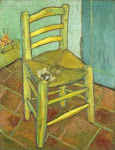

"One and the same person may furnish motifs for very divergent portraits." -Vincent to his sister Wil, June 1888
Dealing with a historical character in a fictional way--whether in writing, film, or other medium--presents a big challenge. How to stay true to that person, how to give that person a believable voice. Van Gogh makes for a particular challenge: he's famous, but most famous for certain things (cutting off part of his ear). How to introduce this 'famous' person in a new way? I did not want to succumb to cliché, and I did not want his illness to be the center of the story, even though by necessity it's a large part of it. Lonely, tormented, grouchy, crazy Vincent--that's been done before. I wanted to share with readers--just like I try to share with my students in class--the Vincent I've gotten to know, who may be lonely, may be ill, but just like anybody, has other sides too.
Above my desk I have prints of two of Vincent's self-portraits, and each pertains to the Vincent I wanted to write about in "The Sunflowers." One dates from Feb 1888, just before he left Paris for Arles, one of two that presents him as a working artist. The popular image may be a crazy Vincent slapping paint on canvas in fits of delirium, but the truth couldn't be further from that. He was a diligent, dedicated artist, mostly self-taught, who never stopped trying new things, even to the end. He had a tremendous knowledge of art history and drew on those influences (Rembrandt and Japanese prints were favorites), and again contrary to myth, engaged frequently with other artists of his generation and counted them as friends (Toulouse-Lautrec, Bernard, Pissarro, Gauguin to name a few). Vincent's innovations in art have often been overshadowed by his illness--indeed, some of his innovations *explained by* his illness, when they should be attributed to his talent and willingness to take risks. "Starry Night" doesn't look the way it does because he was "crazy." It looks the way it does because of him *as artist.*
The other dates from autumn 1886, about 5 or 6 months after Vincent arrived in Paris, when he's still using a darker Dutch color palette. This is my favorite of the self-portraits: there's something about the eyes, an expressiveness, even a vulnerability, that draws me in. (Hence my disappointment when it was not on view at the Gemeentemuseum Den Haag...) That's another point I wanted to explore: too often the illness obscures the man in the popular imagination of van Gogh. He has fallen into cliché. But people might be surprised to find the Vincent revealed in his letters: the one who proclaims, when madly in love with a woman, "I feel energy, new wholesome energy in me, as anyone experiences who truly loves." The one who writes to Theo how he's made a "nest" for Sien Hoornik, his live-in partner, "so that she can feel I have thought of her when she comes into a house with flowers in front of the window where she will sit." By the time Vincent went to Arles, he'd more or less given up on the idea of love, but when he was younger, his romantic dreams are strong. And it's not just about love: Vincent has this reputation of being surly, but he was optimistic more than pessimistic, even about his illness, and he possessed a idealistic view of the world. Even at his most melancholy in his letters, he looks for things to bolster him, his art if nothing else. There were periods in his life where he was quite happy, Feb-Nov 1888 being one of them, when he began to feel settled in Arles and ever more confident in his work. I didn't want a gloomy Vincent stalking the pages of my story when he was not perpetually gloomy, and I didn't want to focus on the dark and dreary. I wanted some sunshine in the story too -- not for nothing did Vincent paint those explosively sunshiny Sunflowers in August 1888. Sunflowers have the lovely quality of turning to follow the sun (the Greeks had a myth about that, which I'll share sometime), even when it is cloudy. So did Vincent.






+-+Wheat+Field+under+Clouded+Sky.jpg)







